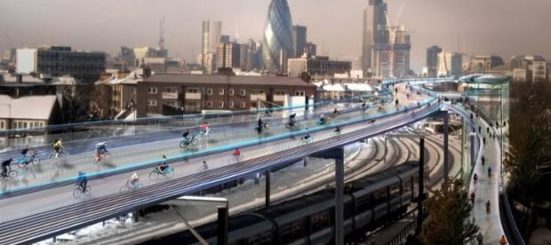The bicycle highway: Plans unveiled for ‘Skycycle’ that lets riders commute far above the railways of London
January 14, 2014

Bicycle advocates clamor for protected facilities that separate bicycle traffic from vehicles and reduce the number of potential conflicts between cars and cyclists. These facilities typically include cycle tracks, which run along the roadway and are separated from traffic by a barrier, and off-road paths, which are often shared with pedestrians and other recreational, non-motorized users.
But a proposal in London has introduced a completely new bike facility: a bike highway, or “Skycycle.”
The proposal calls for elevated bicycle paths to be built above the existing railways in London. The resulting 135 miles of paths would be elevated to about three stories high, and would be accessed by ramps at over 200 points. The first section of Skycycle would be four miles long and would cost £220 million (~ $363 million) to construct.
London’s bicycle mode share (the percentage of commuters who use bikes to travel) is similar to that of Boston (about 2%), but far behind other major European cities such as Amsterdam or Brussels. London also has a major issue with cyclist crashes; they account for 20% of all traffic injuries and fatalities. The Skycycle aims to remove most conflicts from a cyclist’s commute and allow for a safe, fast way to travel through the city. Estimates are that 12,000 cyclists per hour would use Skycycle, improving some commute times by up to 29 minutes.
While the idea of a bicycle superhighway sounds exciting, the idea does have some drawbacks. Special measures would have to be implemented to protect cyclists from wind, since they would be exposed about 30 feet off the ground. The height also presents a challenge concerning the Skycycle egress ramps; these would need to be extremely long to climb 30 feet at a comfortable slope.
The American Association of State Highway Transportation Officials’ (AASHTO) Guide for the Development of Bicycle Facilities, 4th Edition states that the maximum grade for a shared use path along a roadway should be 5%, or five feet of rise for every 100 feet of horizontal length. Following these guidelines, the ramps for the Skycycle would need to be at least 600 feet long. However, even 5% slopes can be challenging for cyclists and could discourage novice cyclists from using Skycycle.
If London goes forward with Skycycle, the city should not abandon efforts to provide safe bicycle accommodations on city streets and intersections. This mega-project would not be effective if Londoners didn’t also feel safe on surface-level roads. Like any other bicycle accommodation, Skycycle will only be as effective as its connections to local neighborhoods, businesses, and recreational areas. The proposal should be viewed as a way to get more Londoners onto the surface streets, not as a way to remove them entirely.
Do you like the idea of a bicycle superhighway? Would you use it if it was provided in your city?
Source article: http://www.dailymail.co.uk/news/article-2530727/The-bicycle-highway-Plans-unveiled-220m-Skycycle-lets-riders-commute-far-railways-London.html

Leave a Comment